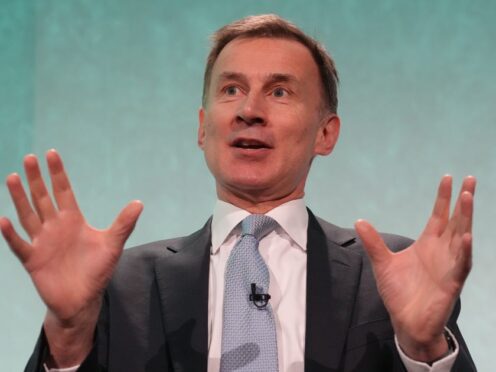
The Chancellor has been given less room to offer Budget tax cuts after official figures showed a smaller-than-expected surplus in January, but giveaway hopes remained as year-to-date borrowing still beat forecasts.
The Office for National Statistics (ONS) said there was a public sector net borrowing surplus of £16.7 billion last month, more than double the £7.5 billion surplus seen a year ago and the largest surplus since monthly records began in 1993.
But it was lower than the £18.5 billion surplus pencilled in by most economists.
Experts said this leaves Jeremy Hunt with a smaller headroom to deliver tax giveaways on March 6 in what is set to be a crucial event for the Government, marking the last spring Budget before an expected general election later this year.
It follows the economic blow last week, when official data revealed the UK fell into recession at the end of 2023 after the second quarter in a row of falling output.
But economists said there was some cheer for the Chancellor as revisions to data from previous months meant borrowing for the financial year to March should come in below the £123.9 billion forecast by the UK’s fiscal watchdog, the Office for Budget Responsibility (OBR).
Chief Secretary to the Treasury Laura Trott said the Government “will not speculate” on whether borrowing figures have given it room to deliver tax cuts in the Budget.
She said: “We have taken tough decisions to help reduce borrowing versus what the OBR expected in March.

“While we will not speculate over whether further reductions in tax will be affordable in the Budget, the economy is beginning to turn a corner, with inflation down from over 11% to 4%.”
The Government typically sees a budget surplus – which takes place when tax revenue received is larger than government spending – in January thanks to self-assessment tax payments.
The surplus widened substantially last month as debt interest payments eased back and without the costly energy support payments that were seen a year earlier.
However, other Government outlays rose faster than expected, while growth in tax receipts came in below expectations, leaving the surplus shy of forecasts.
Despite this, the ONS revealed borrowing in the first 10 months of the financial year so far stood at £96.6 billion, £3.1 billion less than the same period a year ago and lower than the £105.8 billion forecast by the OBR.
Ellie Henderson, an economist at Investec, said Mr Hunt “won’t be celebrating yet”.
She added: “Although the healthy January figure will no doubt be an accolade that the Conservative Party will publicly celebrate, in regard to the read-through to the fiscal headroom available for the upcoming March 6 Budget, today’s data was slightly disappointing.”
It comes amid reports that Mr Hunt has now received the OBR’s latest round of economic and fiscal forecasts, although these will not be published until he delivers the Budget.
Rumours are swirling over possible plans to cut the basic rate of income tax as the Government looks to deliver giveaways with mass appeal ahead of the election.
Martin Beck, chief economic adviser to the EY Item Club, said: “The Chancellor will have room to manoeuvre, but major tax cuts are looking less likely.
“Investors reining back their expectations on interest rate cuts this year, a weaker-than-expected economy, and some fiscal downsides from lower inflation have cut the likely scale of any extra headroom.”

The figures show the UK’s overall national debt was £2.65 trillion in January, an increase on the £2.49 trillion seen a year ago.
It means debt as a share of the economy represented 96.5% of UK gross domestic product (GDP) and remained at levels last seen in the early 1960s, according to the ONS.
Debt interest payments stood at £4.4 billion last month, which was £3.5 billion less than a year earlier and the lowest January figures since 2021.
Britain’s debt interest bill is falling because of the benefit of lower levels of RPI inflation, which impacts index-linked gilt stock.

Enjoy the convenience of having The Sunday Post delivered as a digital ePaper straight to your smartphone, tablet or computer.
Subscribe for only £5.49 a month and enjoy all the benefits of the printed paper as a digital replica.
Subscribe